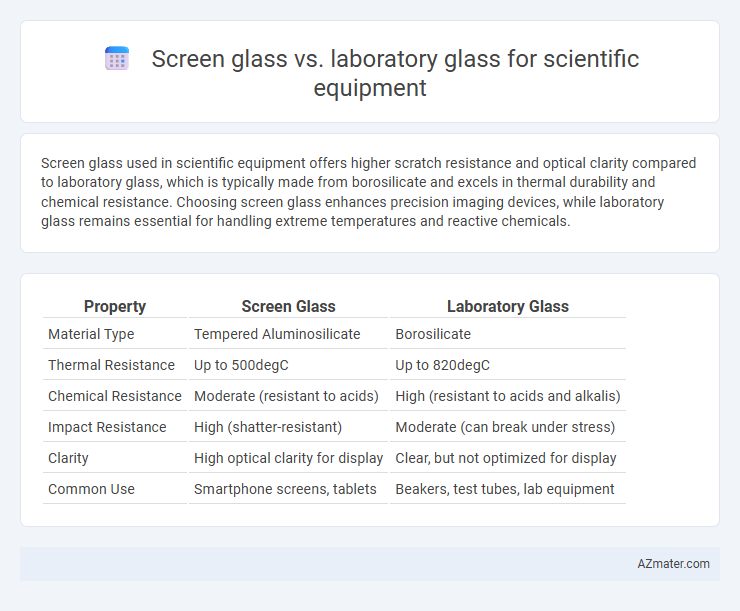Screen glass used in scientific equipment offers higher scratch resistance and optical clarity compared to laboratory glass, which is typically made from borosilicate and excels in thermal durability and chemical resistance. Choosing screen glass enhances precision imaging devices, while laboratory glass remains essential for handling extreme temperatures and reactive chemicals.
Table of Comparison
| Property | Screen Glass | Laboratory Glass |
|---|---|---|
| Material Type | Tempered Aluminosilicate | Borosilicate |
| Thermal Resistance | Up to 500degC | Up to 820degC |
| Chemical Resistance | Moderate (resistant to acids) | High (resistant to acids and alkalis) |
| Impact Resistance | High (shatter-resistant) | Moderate (can break under stress) |
| Clarity | High optical clarity for display | Clear, but not optimized for display |
| Common Use | Smartphone screens, tablets | Beakers, test tubes, lab equipment |
Introduction to Scientific Glassware
Scientific glassware plays a crucial role in experimental accuracy and safety, with screen glass and laboratory glass serving distinct purposes. Screen glass, often made from tempered or laminated glass, provides a durable barrier for display and protection, while laboratory glass, typically borosilicate, offers high thermal resistance and chemical durability essential for precise experiments. Selecting the appropriate glass type ensures optimal performance, reliability, and safety in scientific applications.
Composition of Screen Glass
Screen glass in scientific equipment is primarily composed of aluminosilicate or soda-lime glass, engineered for enhanced durability and high resistance to thermal shock and scratches, making it suitable for touchscreens and display panels. Laboratory glass, often borosilicate glass, contains silica and boron trioxide, offering superior chemical resistance and thermal stability for reactions and sample containment. The distinct composition of screen glass prioritizes mechanical strength and optical clarity, whereas laboratory glass focuses on chemical inertness and thermal tolerance.
Composition of Laboratory Glass
Laboratory glass is primarily composed of borosilicate, which offers superior chemical resistance and thermal stability compared to standard screen glass made mainly from soda-lime silica. Borosilicate glass contains approximately 80% silica (SiO2) and 13% boric oxide (B2O3), enhancing its durability under rapid temperature changes and exposure to corrosive substances. This specialized composition makes laboratory glass ideal for scientific equipment requiring precise measurements and resistance to chemical reactions.
Thermal Resistance Comparison
Screen glass typically offers moderate thermal resistance, suitable for display protection but limited in high-temperature environments. Laboratory glass, especially borosilicate varieties like Pyrex, provides superior thermal resistance, withstanding rapid temperature changes up to 500degC without cracking. This makes laboratory glass essential for scientific equipment subjected to intense heating and cooling cycles.
Chemical Durability Differences
Screen glass and laboratory glass differ significantly in chemical durability due to their composition and intended use. Laboratory glass, often made from borosilicate or fused silica, exhibits high resistance to acids, bases, and solvents, ensuring minimal chemical interaction during experiments. In contrast, screen glass, typically composed of aluminosilicate or soda-lime glass, demonstrates lower chemical resistance, making it less suitable for exposure to harsh laboratory chemicals or prolonged contact with reactive substances.
Mechanical Strength Evaluation
Screen glass exhibits higher mechanical strength and scratch resistance compared to laboratory glass, making it suitable for protective screens and devices requiring durability under frequent handling. Laboratory glass, typically borosilicate, offers excellent thermal resistance and chemical stability but has lower impact resistance and susceptibility to breakage under mechanical stress. Mechanical strength evaluation often reveals that screen glass withstands greater flexural stress and hardness tests, whereas laboratory glass prioritizes thermal shock resistance over mechanical toughness.
Optical Clarity and Transparency
Screen glass exhibits superior optical clarity and transparency compared to laboratory glass, making it ideal for applications requiring precise visual inspection and minimal light distortion. Laboratory glass, while durable and chemically resistant, often contains impurities and thickness variations that can reduce light transmission and clarity. High-quality screen glass is engineered to maintain consistent transparency and scratch resistance, enhancing the accuracy of scientific observations and imaging.
Cost and Accessibility
Screen glass offers a cost-effective and widely accessible option for scientific equipment, often used in low-budget or educational settings due to its lower manufacturing expenses. Laboratory glass, such as borosilicate glass, commands a higher price because of its chemical resistance, thermal durability, and precision manufacturing processes, making it essential for advanced scientific applications. Availability of laboratory glass is more restricted and often requires specialized suppliers, whereas screen glass is more readily obtainable through general retail channels.
Suitability for Laboratory Applications
Screen glass offers high optical clarity and scratch resistance but lacks chemical resistance and thermal stability necessary for rigorous laboratory applications. Laboratory glass, such as borosilicate glass, provides exceptional resistance to thermal shock, chemical corrosion, and mechanical stress, making it ideal for precise scientific experiments. Selecting laboratory glass ensures durability and safety in environments involving heat, acids, and solvents, outperforming standard screen glass in functionality and reliability.
Conclusion: Choosing the Right Glass for Scientific Equipment
Screen glass offers superior scratch resistance and optical clarity important for display-based scientific instruments, while laboratory glass excels in chemical resistance and thermal stability essential for experimental setups. Selecting the appropriate glass depends on the specific application requirements, such as mechanical durability for handling or inertness against reagents in chemical reactions. Ensuring compatibility with scientific tasks enhances equipment performance and longevity, making informed glass choice critical for research accuracy and safety.

Infographic: Screen glass vs Laboratory glass for Scientific equipment
 azmater.com
azmater.com